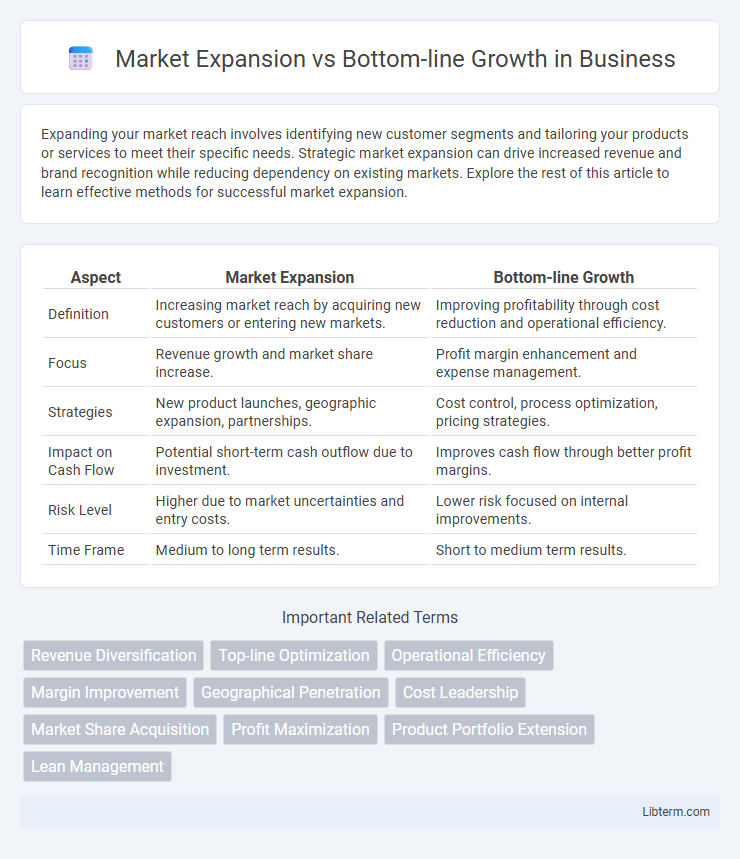Expanding your market reach involves identifying new customer segments and tailoring your products or services to meet their specific needs. Strategic market expansion can drive increased revenue and brand recognition while reducing dependency on existing markets. Explore the rest of this article to learn effective methods for successful market expansion.
Table of Comparison
| Aspect | Market Expansion | Bottom-line Growth |
|---|---|---|
| Definition | Increasing market reach by acquiring new customers or entering new markets. | Improving profitability through cost reduction and operational efficiency. |
| Focus | Revenue growth and market share increase. | Profit margin enhancement and expense management. |
| Strategies | New product launches, geographic expansion, partnerships. | Cost control, process optimization, pricing strategies. |
| Impact on Cash Flow | Potential short-term cash outflow due to investment. | Improves cash flow through better profit margins. |
| Risk Level | Higher due to market uncertainties and entry costs. | Lower risk focused on internal improvements. |
| Time Frame | Medium to long term results. | Short to medium term results. |
Understanding Market Expansion
Market expansion involves entering new geographic regions or targeting different customer segments to increase revenue streams and diversify market risk. It requires thorough market research, competitive analysis, and adaptation of products or services to local preferences and regulatory environments. Successful market expansion enhances brand presence and lays the foundation for sustainable bottom-line growth by increasing sales volume and customer base.
Defining Bottom-line Growth
Bottom-line growth refers to the increase in a company's net income after all expenses, taxes, and costs have been deducted from total revenue. It emphasizes profitability improvement by optimizing operational efficiency, reducing costs, and enhancing revenue quality rather than solely boosting sales volume. Effective bottom-line growth strategies directly impact shareholder value by increasing earnings per share and sustainable cash flow.
Key Differences Between Market Expansion and Bottom-line Growth
Market expansion focuses on increasing a company's customer base and entering new geographic or demographic markets, driving revenue through higher sales volume. Bottom-line growth prioritizes improving net profit by reducing costs, enhancing operational efficiency, and increasing profit margins. The key difference lies in market expansion aiming for revenue growth, whereas bottom-line growth targets overall profitability improvement.
Benefits of Market Expansion Strategies
Market expansion strategies enable businesses to access new customer segments and geographic regions, driving increased revenue potential and brand recognition. By diversifying market presence, companies reduce dependency on existing markets, enhancing resilience against economic fluctuations. This approach fosters innovation and competitive advantage through adapting products and services to varied consumer needs, ultimately supporting sustainable long-term growth.
Advantages of Prioritizing Bottom-line Growth
Prioritizing bottom-line growth enhances profitability by focusing on cost-efficiency and increasing net income, which strengthens a company's financial stability and investor appeal. This strategy allows for improved cash flow management, enabling reinvestment in core operations and debt reduction. Concentrating on bottom-line growth also fosters sustainable business practices that can withstand market fluctuations better than aggressive market expansion.
Risks and Challenges in Market Expansion
Market expansion presents significant risks including unfamiliar regulatory environments, cultural barriers, and increased operational complexity, which can strain resources and dilute brand identity. Companies face challenges like misjudging local demand, underestimating competition, and failing to adapt marketing strategies effectively, potentially leading to lost investments. Navigating these risks requires robust market research, strategic partnerships, and agile management to mitigate financial exposure and ensure sustainable growth.
Obstacles to Achieving Bottom-line Growth
Obstacles to achieving bottom-line growth often include rising operational costs, inefficient resource allocation, and competitive pricing pressures. Companies may face challenges in improving profit margins due to fixed expenses and fluctuating demand in their core markets. Limited innovation and low productivity can further restrict sustainable bottom-line improvements despite efforts to increase revenue.
When to Choose Market Expansion Over Bottom-line Growth
Choose market expansion when your business has strong market demand and sufficient resources to invest in scaling operations, enabling long-term revenue increases. Expanding into new markets or segments can offset stagnating profit margins and diversify income streams, reducing reliance on a single source. Prioritize market expansion to build brand presence and competitive advantage before optimizing cost efficiency for bottom-line growth.
Balancing Market Expansion and Profit Optimization
Balancing market expansion and profit optimization requires strategic allocation of resources to enter new markets while maintaining cost efficiency and margin control. Prioritizing scalable business models and data-driven market analysis ensures sustainable growth without eroding the bottom line. Effective pricing strategies and operational efficiencies contribute to maximizing profitability alongside market penetration.
Case Studies: Successful Market Expansion vs Bottom-line Growth
Case studies of successful market expansion highlight companies entering new geographic regions or demographics, which resulted in increased revenue streams and brand recognition, such as Netflix's international rollout that drove subscriber growth. In contrast, bottom-line growth case studies emphasize cost optimization and efficiency improvements, exemplified by Toyota's lean manufacturing approach that significantly boosted profit margins. Evaluating Amazon's dual strategy reveals how simultaneous market expansion and operational excellence contributed to sustained financial performance and competitive advantage.
Market Expansion Infographic

 libterm.com
libterm.com